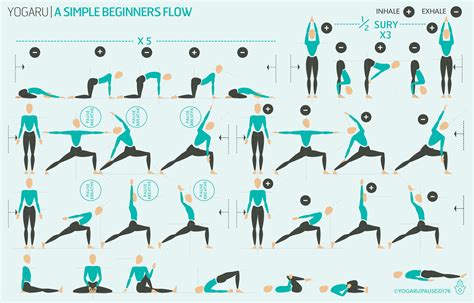Invigorate Your Day: A Basic Yoga Flow for Boosting Energy
Feeling sluggish or mentally drained? Yoga might just be the perfect solution. This ancient practice is not only renowned for its physical benefits, but it also helps balance energy, sharpen focus, and increase mental clarity. By incorporating a basic yoga flow into your routine, you can revitalize your energy levels and improve overall well-being. This article delves into a simple yet effective yoga sequence designed to boost energy while discussing the key concepts, historical background, practical applications, and ethical considerations surrounding this timeless practice.
Introduction
Whether you’re a seasoned yogi or a beginner, yoga’s energy-enhancing potential is immense. This basic flow isn’t just about flexibility or strength; it’s about cultivating energy that leaves you feeling refreshed, balanced, and ready for the day. In this guide, we will break down a fundamental yoga flow that anyone can practice, its benefits, and how to apply it to boost energy in everyday life.
Key Concepts of Yoga for Energy
- Prana: The concept of life energy or “prana” is central to yoga. Pranayama (breathing exercises) helps to control this energy and enhance vitality.
- Asanas: Physical postures designed to balance energy flow within the body, with some poses being especially energizing.
- Mindfulness: Focusing your mind on the present moment through breath and movement increases clarity and mental sharpness, contributing to sustained energy.
- Energy Centers (Chakras): Yoga teaches that energy flows through the body via chakras. Certain poses are designed to stimulate specific chakras, particularly the root and sacral chakras, to enhance vitality.
Historical Context of Yoga for Energy
Yoga, an ancient practice originating in India over 5,000 years ago, was traditionally designed to unify the mind, body, and spirit. Although initially focused on spiritual enlightenment, the physical benefits, including energy revitalization, have become a global focus in modern yoga. The link between breath control (pranayama), posture (asana), and energy cultivation was first documented in the ancient texts of the Yoga Sutras by Patanjali.
By the 20th century, modern styles of yoga such as Ashtanga, Hatha, and Vinyasa emerged, each promoting energy enhancement through varied sequences and breath work. Today, many yoga flows are designed specifically to combat fatigue and restore vitality, adapting these ancient techniques to contemporary lifestyles.
Current State Analysis
In today’s fast-paced world, fatigue and burnout are rampant, leading to a growing interest in holistic approaches to wellness, including yoga. According to recent studies, regular yoga practice significantly boosts energy levels, reduces stress, and enhances overall well-being. The adoption of yoga as a tool for physical and mental energy restoration is evident in corporate wellness programs, schools, and fitness communities worldwide. There is a growing body of research on how specific yoga flows, like Sun Salutations, are particularly effective in enhancing circulation and releasing endorphins, leading to increased energy levels.
Practical Applications: A Simple Yoga Flow for Energy
Below is a simple yet effective yoga sequence that can be practiced daily to boost energy:
| Pose | Benefit | Instructions |
|---|---|---|
| Mountain Pose (Tadasana) | Grounding and centering | Stand tall with feet together, grounding through the feet, and lengthening the spine. |
| Upward Salute (Urdhva Hastasana) | Opens the chest and stretches the spine | Raise your arms overhead, spreading the fingers wide, and look upward. |
| Standing Forward Bend (Uttanasana) | Improves circulation | Bend forward from the hips, allowing the head to hang heavy and releasing tension in the spine. |
| Low Lunge (Anjaneyasana) | Strengthens legs and opens hips | Step one foot back into a lunge, lowering the back knee and stretching arms overhead. |
| Downward-Facing Dog (Adho Mukha Svanasana) | Energizes and stretches the entire body | Lift your hips high, pressing heels toward the ground, and spread your fingers wide. |
| Cobra Pose (Bhujangasana) | Opens the chest and boosts energy | Lie on your stomach, placing hands under your shoulders, and lift your chest while keeping elbows slightly bent. |
| Child’s Pose (Balasana) | Restores and grounds energy | Kneel on the ground, extending arms forward, and rest the forehead on the mat. |
| Seated Forward Bend (Paschimottanasana) | Calms the mind and stretches the back | Sit with legs extended and fold forward, reaching for your toes. |
| Corpse Pose (Savasana) | Integrates the practice and relaxes the body | Lie flat on your back with arms by your sides, and focus on your breath. |
Practicing this sequence in the morning or during a midday energy slump can help to reset both body and mind, allowing for increased productivity and focus throughout the day.
Case Studies: Yoga for Energy in Different Contexts
- Corporate Wellness: Studies have shown that companies implementing yoga programs see a 20% increase in employee energy levels and productivity.
- Schools: Schools incorporating yoga into the daily curriculum report improved student focus and reduced restlessness, directly linking movement to mental clarity and energy.
- Personal Testimonials: Many individuals suffering from chronic fatigue report significant improvements in energy levels after practicing yoga consistently for three months.
Stakeholder Analysis
Yoga practice involves various stakeholders, each with unique perspectives:
- Individuals: Looking for natural ways to enhance energy and reduce fatigue.
- Employers: Implementing yoga programs to increase employee energy and productivity.
- Healthcare Professionals: Recommending yoga as a complementary treatment for fatigue and stress.
- Yoga Instructors: Offering specific flows targeting energy restoration.
Implementation Guidelines for a Daily Yoga Flow
- Set aside 15-30 minutes each day, ideally in the morning or mid-afternoon.
- Find a quiet space where you won’t be disturbed.
- Practice the flow at your own pace, focusing on your breath.
- Adjust the sequence based on your energy levels, adding more dynamic poses if needed.
- Consistency is key—try to practice at least three times a week for noticeable results.
Ethical Considerations
As yoga becomes more commercialized, it’s important to address several ethical concerns:
- Accessibility: Ensuring that yoga is inclusive and accessible to all, regardless of income or physical ability.
- Cultural Appropriation: Respecting the origins of yoga and ensuring that the practice remains true to its roots.
- Instructor Certification: Ensuring that instructors are properly trained to guide students safely, particularly in energy-enhancing flows.
Limitations and Future Research
While yoga is effective in boosting energy, its full potential is still being explored. Future research could focus on:
- Measuring long-term effects of yoga on energy levels across diverse populations.
- Exploring the impact of yoga on specific conditions like chronic fatigue syndrome.
- Developing customized flows based on individual energy needs.
Expert Commentary
Experts agree that yoga offers a powerful, natural way to enhance energy. As one yoga teacher put it, “Yoga is a tool that tunes the body and mind, helping you access a deep reservoir of energy you didn’t even know you had.” From increased circulation to mental clarity, the benefits are profound and can be felt immediately after a session. By incorporating regular practice, individuals can tap into these benefits and








